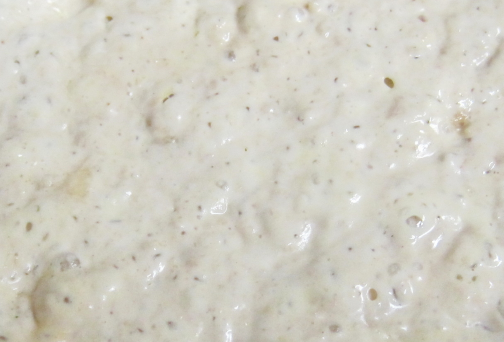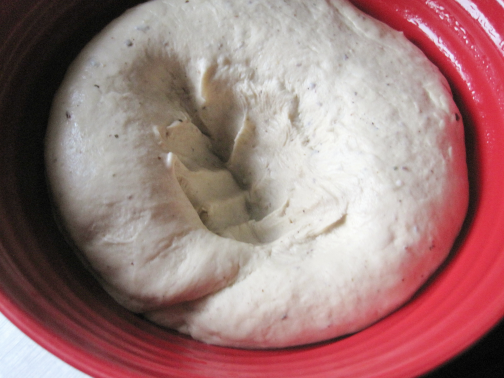Yesterday was Thanksgiving. We happened to have some very good, very moist leftover stuffing, but not enough for both of us to have it again today, so I used it to make bread for sandwiches. Since I’m still curious what makes “milk bread” have it’s unique texture and crust. It’s not the milk, so perhaps it’s using some precooked flour (in this case the croutons in the stuffing.) I may be onto something here – this bread does have the soft crust and delightful texture of milk bread. It’s got the same oven spring. Yet it tastes completely different. There are so many herbs and spices in it, that it would never work for dinner rolls and, traditionally all milk bread is made as some type of dinner roll. But it makes fantastic sandwich bread.
How many loaves this makes depends on how much stuffing you start with.
1 part stuffing (made from store bought croutons)
1 part freshly fed sourdough starter
Mix well (all of the stuffing should be well coated) and let it work overnight. (We always add some minced onion, minced celery, some raisins, and brown sugar to our stuffing, and let the turkey provide all the liquid.)

Put 2 tablespoons of butter in the freezer to harden.

The next day add 1 Cup warm water to the starter mix, stir well, and set aside.
In the bowl of your stand mixer combine:
3 cups bread flour (hard flour)
Read the stuffing packaging to see what herbs and spices to add — add about 1 teaspoon of each herb or spice listed. Instead of salt, add 1 teaspoon Vegeta. Stir the dry ingredients together.
Use a cheese slicer (or potato peeler) to get thin sheets of your frozen butter, and cut (or pinch) it into the dry ingredients until it looks like fine cornmeal.
Add the starter mixture to the flour mixture and stir. This is where things get a bit tricky since the moisture content of both the stuffing and the sourdough starter can vary greatly. If your dough is sticky, add more flour, about 1/4 C at a time. If your dough won’t form a breakable ball, add more water, about 1 tablespoon at a time. I always mix my dough by hand when I’m not sure of the measurements. The goal is a dough that’s a tiny bit dry, and not in the least bit sticky – but all the flour is used up. You should be able to roll the dough into a breakable ball that easily kneads back together. When you think the dough is ready, let it rest for 15 minutes.

If, after a 15 minute rest (while you lightly oil the bowl you’ll use to let the dough rise,) the dough still isn’t sticky, it’s time to put it in your stand mixer. Knead in your stand mixer (or bread machine, or by hand) until your dough can pass the window pane test – about 10 minutes. (If you’ve ever wondered why I don’t make my own videos, it’s because I only have one arm that works, so I do things a tad differently than most people.) The dough still isn’t sticky.
Roll into a ball, and place it in your lightly oiled bowl, turning it over a few times to coat with the oil. Cover it tightly and place it in a warm, moist place to rise until doubled in size. (About an hour.)


Punch it down (it’s still not sticky.) and knead lightly on a clean, dry, hard surface. (If you started with a lot of stuffing, you may have to divide the dough in half.) Then make a rectangle, where the small side is slightly less than the width of your bread pan(s), and roll it up tightly, being careful to keep the roll the same width as your bread pan(s.)

Lightly oil your bread pan(s) and place the shaped dough in the pan. Allow to rise until dough is even with the height of the pan.

Slash the dough deeply (my slashing skills need work.) and bake in a 350° F for 30 – 40 minutes or until bread tests done.
For the best texture for sandwiches, allow to cool before cutting.




great post
LikeLiked by 1 person
What a clever idea. Incorporating stuffing into sourdough bread is entirely new to me.
BTW, your posts inspired me to get starter a month or so ago. I’ve already made pizza, bread, a Latvian apple cake, and some breakfast rolls. Many thanks!
LikeLiked by 1 person